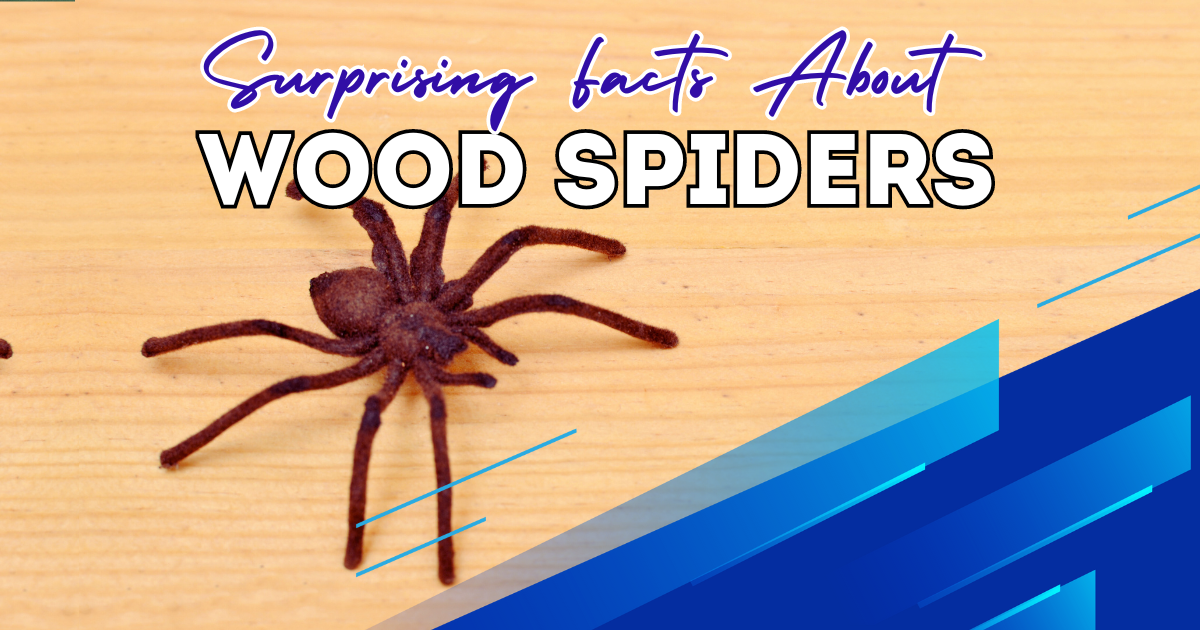Introduction: Unveiling the Wood Spider – Nature’s Camouflaged Hunter
The world of spiders is vast and diverse, with species that inhabit nearly every corner of the planet. Among these arachnids, the wood spider stands out as a master of camouflage, blending seamlessly into forest environments and wooden structures. Though often overlooked due to their ability to hide so effectively, wood spiders play an essential role in maintaining the balance of ecosystems by controlling insect populations.
In this article, we will explore the fascinating world of wood spiders, uncovering their habitat, behavior, and role in nature. We’ll also address common concerns about whether they are dangerous to humans and provide tips on how to identify and safely remove them from your home if needed.
What Is a Wood Spider? Understanding Its Characteristics
A wood spider is a general term used to describe various spider species that live in and around wooded areas, forests, and wooden structures. These spiders are known for their ability to blend in with their surroundings, often making them difficult to spot. Unlike brightly colored spiders, they are typically brown, gray, or black, allowing them to remain camouflaged against the bark of trees or the wood of outdoor structures.
Key Characteristics of Wood Spiders
- Size: They can range in size, but many species are medium to large, with leg spans reaching several inches.
- Color: Their colors tend to be neutral—brown, gray, or black—matching their environment for optimal camouflage.
- Body Shape: They often have sturdy, robust bodies, with long legs that allow them to move quickly across surfaces.
- Webs: Some species of these spiders create intricate webs to catch their prey, while others are active hunters that rely on stealth and speed.
They are not a specific species but rather a term used to describe several types of spiders that live in similar habitats. As such, there can be a wide variation in their size, appearance, and behavior.
Wood Spider Habitat: Where Do They Live?
As their name suggests, wood spiders are commonly found in forested areas, wood piles, and wooden structures such as barns, sheds, and cabins. They prefer environments where they can easily camouflage themselves, and wood offers the perfect backdrop for their earthy tones. Whether they are living in dense forests or inhabiting man-made wooden structures, they are experts at blending into their surroundings.
Natural Habitats
Wood spiders thrive in temperate forests, tropical jungles, and even urban parks where trees and wooden structures are abundant. In these environments, they can often be found hiding under bark, within cracks in tree trunks, or among fallen branches and leaves.
In and Around Human Habitations
In addition to natural wooded areas, wood spiders may also be found in homes, especially in attics, basements, or storage areas where wood is stored. They are drawn to dark, quiet places where they can hunt for insects without being disturbed.
Key Habitat Features:
- Forests and wooded areas
- Wood piles and logs
- Cabins, barns, and wooden sheds
- Under bark or in cracks and crevices
Types of Wood Spiders and Their Unique Traits
While there are many types of spiders that can be classified as wood spiders, certain species are more commonly associated with wooded environments. Below are a few examples of wood spiders and their unique traits:
1. Huntsman Spider (Sparassidae)
The Huntsman spider is often found in wooded areas and is known for its large size and speed. With a leg span that can reach up to 12 inches, these spiders are active hunters that do not rely on webs to catch their prey. They are fast and agile, often ambushing insects and small animals.
2. Woodlouse Spider (Dysdera crocata)
The Woodlouse spider gets its name from its preference for hunting woodlice and other small arthropods. With a reddish body and large fangs, it is a fierce predator that lives in wood piles, under logs, and in leaf litter.
3. Cellar Spider (Pholcidae)
While commonly found in homes, the Cellar spider can also be considered a wood spider because of its affinity for dark, secluded places. These spiders create delicate webs in wood structures like basements and sheds and are easily identified by their long, spindly legs.
Wood Spider Behavior: How Do They Hunt and Survive?
They are excellent hunters, using a combination of camouflage, speed, and stealth to capture their prey. Unlike some other spider species that rely on webs, many of these spiders are active hunters, meaning they stalk and chase their prey rather than waiting for it to become entangled in a web.
1. Hunting Techniques
Some wood spiders, like the Huntsman spider, rely on their ability to move quickly and strike at unsuspecting prey. They are nocturnal hunters, preferring to catch insects under the cover of darkness. Other wood spiders, like the Orb-weaving spider, create intricate webs in wooded areas or between branches to trap their prey.
2. Diet
They primarily feed on insects, including beetles, flies, and moths. Some larger spiders may also prey on small vertebrates like frogs or lizards if the opportunity arises.
3. Survival Strategies
The ability to blend into their surroundings provides wood spiders with protection from predators. Their camouflage allows them to hide from birds, small mammals, and other creatures that might prey on them.
Key Behavioral Traits:
- Active hunting or web-building
- Nocturnal activity
- Diet consists of insects and small animals
- Excellent camouflage
Are Wood Spiders Dangerous to Humans?
A common concern for many people is whether they pose a threat to humans. In most cases, they are not dangerous. While some species, like the Huntsman spider, may look intimidating due to their size, they are generally harmless and will avoid contact with humans whenever possible.
1. Bites
Although they may bite if they feel threatened, their bites are usually non-venomous and pose little risk to humans. The bites may cause minor irritation, swelling, or redness, similar to a bee sting, but serious reactions are rare.
2. Defensive Behavior
Wood spiders, like most spiders, prefer to flee rather than fight when they encounter humans. They are not aggressive by nature and will only bite in self-defense if cornered or provoked.
How to Identify and Get Rid of Wood Spiders in Your Home
If you discover them in your home or around your property, it’s important to identify them correctly and take appropriate action. Here’s how to identify wood spiders and safely remove them from your living space:
1. Identification
- Color: They are typically brown, gray, or black, allowing them to blend in with wood or bark.
- Size: Wood spiders range in size, with some species, like the Huntsman, being quite large.
- Location: Look for wood spiders in dark, quiet areas such as wood piles, basements, or attics.
2. Removal
To get rid of them in your home:
- Clean regularly: Regular cleaning and vacuuming can help remove spiders and their webs.
- Seal cracks and crevices: Close off any small gaps or entry points that spiders could use to enter your home.
- Natural deterrents: Use natural deterrents like peppermint oil or vinegar, which are known to repel spiders.
- Professional pest control: If you have a significant infestation, contact a professional pest control service to remove the spiders safely.
Curious about other tiny spider species? Check out 10 Surprising Facts About Baby Wolf Spiders You Won’t Believe for more intriguing spider trivia! Click here to read!
Conclusion: The Important Role of Wood Spiders in Nature’s Ecosystem
While wood spiders may not always be welcome visitors in our homes, they play an important role in the natural world. By controlling insect populations, they help maintain a balance in ecosystems and contribute to the health of forests and wooded areas. These fascinating creatures deserve respect for their role as efficient predators and nature’s natural pest controllers.
Understanding more about wood spiders, their behavior, and their habitat can help reduce fear and foster appreciation for these remarkable arachnids. Whether you encounter them in your backyard or deep in the woods, remember that they are a vital part of the ecosystem, working quietly behind the scenes to keep nature in balance.
FAQs About Wood Spiders
- What is a wood spider?
- It is a general term for spiders that live in wooded areas or wooden structures. These spiders are typically brown, gray, or black and are known for their camouflage abilities.
- Where do wood spiders live?
- They can be found in forests, wood piles, and wooden structures like sheds, barns, and cabins. They thrive in areas with lots of wood and natural debris.
- Are wood spiders dangerous?
- They are generally not dangerous to humans. While they may bite if threatened, their bites are usually harmless and cause only minor irritation.
- What do wood spiders eat?
- These spiders primarily feed on insects, such as beetles, flies, and moths. Some larger wood spiders may also prey on small vertebrates like frogs or lizards.
- How can I get rid of wood spiders in my home?
- To get rid of them, clean regularly, seal cracks and crevices, and use natural deterrents like peppermint oil. For significant infestations, contact professional pest control.
- Do wood spiders make webs?
- Some of these spiders, such as Orb-weaving spiders, make webs to catch their prey, while others, like Huntsman spiders, are active hunters that do not rely on webs.
- Can wood spider bites cause serious reactions?
- Most of them bites cause minor irritation, swelling, or redness, but serious reactions are rare. If you experience any unusual symptoms after a bite, consult a medical professional.
- Why are wood spiders important for the environment?
- They help control insect populations, playing a vital role in maintaining ecological balance in forests and wooded areas.
- What types of wood spiders are there?
- Some common types of these spiders include the Huntsman spider, Woodlouse spider, and Cellar spider.
- Do wood spiders live indoors?
- While they prefer outdoor wooded areas, they can sometimes be found indoors, particularly in basements, attics, and storage areas.

Joseph Bush is a seasoned writer and researcher with over 7 years of experience covering a wide range of general topics, from lifestyle and technology to business and current events. He is dedicated to producing fact-checked, reader-friendly content that informs, engages, and empowers readers.
Throughout his career, Joseph has followed strict editorial guidelines, relied on reputable sources, and ensured every article meets the highest standards of accuracy and clarity. His expertise spans multiple fields, allowing him to explain complex topics in a way that’s easy to understand.
Passionate about continuous learning, Joseph stays updated on industry trends and best practices to deliver trustworthy, well-rounded insights. Readers can rely on his work for its credibility, depth, and real-world relevance.




